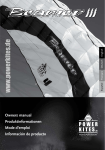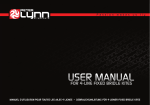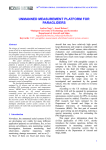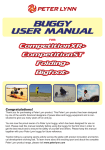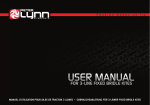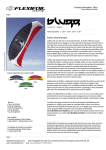Download Owners manual Produktinformationen Mode d'emploi Información
Transcript
English Deutsch Français Español Owners manual Produktinformationen Mode d’emploi Información de producto English Français HQ CROSSFIRE 2 HQ CROSSFIRE 2 operating instructions Mode d’emploi Congratulations on your purchase of an HQ CROSSFIRE. These kites create excitement and hours of fun for the user; however, you should first read these instructions completely and always respect the safety information. Vous venez d’acheter une CROSSFIRE HQ et nous vous en félicitons. Cet engin de sport vous procurera beaucoup de plaisir. Avant l’utilisation, vous devez lire attentivement ce mode d’emploi et absolument respecter les consignes de sécurité. HQ developed the CROSSFIRE to be used as parafoils. Handling requires discretion and practice and occasionally courage. The speed, pulling force and maneuverability can surprise even the most experienced pilots if they are not familiar with the kite. Les CROSSFIRE sont spécialement conçues comme ailes de traction. Leur pilotage exige prudence, contrôle et parfois aussi un gros cœur. La vitesse, la maniabilité et la traction développée peut surprendre même des pilotes avertis, tant qu’ils ne sont pas habitués au cerf-volant. Deutsch Español HQ CROSSFIRE 2 HQ CROSSFIRE 2 Bedienungsanleitung Instrucciones de manejo de Wir beglückwünschen Sie zum Kauf einer HQ CROSSFIRE. Dieses Sportgerät wird Ihnen viel Spaß bereiten. Allerdings sollten Sie vorher diese Anleitung gründlich lesen und auf jeden Fall die Sicherheitshinweise beachten. Le felicitamos por la compra de su HQ CROSSFIRE. Este artículo deportivo le deparará muchas horas de disfrute. No obstante, antes de utilizarlo debe leer a fondo estas instrucciones y tener siempre en cuenta las instrucciones de seguridad. Die HQ CROSSFIRE wurden für den Einsatz als Zugschirme entwickelt. Der Umgang mit ihnen erfordert Umsicht und Übung – und manchmal auch Mut. Geschwindigkeit, Zugkraft und Manövrierfähigkeit können selbst erfahrene Piloten überraschen, solange sie mit dem Drachen nicht vertraut sind. Los CROSSFIRE han sido desarrollados para su uso como parapentes de tracción. Su manejo requiere precaución y práctica, en ocasiones también audacia. La velocidad, la fuerza de tracción y la maniobrabilidad pueden sorprender incluso a los pilotos experimentados si no están familiarizados con la cometa. Graphics: Alex Hesse Copyright by INVENTO 2007 2 Safety Rules Do not fly your kite within range of people or vehicles! 2. Onlookers should stand behind the pilot for maximum safety! 3. Sport kites are not toys. Being hit by a flying kite could result in injury or death. Control lines can cause serious cuts. Flying close to moving vehicles can distract the driver and cause an accident. 4. Stop flying when conditions become strong or unpredictable! 5. In strong winds sport kites can pull you to the ground and drag you downwind, potentially causing injury and death. 6. Do not fly around electrical lines or thunder storms! Wet lines can conduct electricity. Kites contacting electricial lines, or being hit by lightning can cause serious injury or death. 7. Never attempt to disentangle from power lines. 8. This product should only be used by a child under competent adult supervision. 9. Never use this kite or any HQ Kites product to jump, fly (paraglide) or rise above the ground. By jumping, you seriously increase the chances of serious injury, paralysis or death. 10. Never leave your kite unattended. Flying traction kites and the related sports, for example, buggying, are among extreme sports and should be participated in with the appropriate respect. Inappropriate use of the material can lead to serious or even fatal injuries! This makes it all the more important that you read and follow the operating instructions and the safety rules! Warranty and Liability a guarantee cannot be taken over: t damaged as a result of normal wear and tear, misuse or neglect t repaired or modified without the authorisation of HQ-Invento. t returned to HQ-Invento without a valid receipt t All moving parts are basically wear parts. Check your kite continuously for abrasion and replace damaged parts before you use your kite. t HQ-InVento shall not be liable for any injury, loss or damage arising from the use of this kite. t For your own safty you must read and understand the entire manual, and all the instructions and warnings contained within it. You must also ensure that any other user of your HQ-Kite reads and understand the safty instructions contained within this manual before using the kite t HQ developed the CROSSFIRE to be used as a powerkite. Handling requires discretion and practice and occasionally courage. The speed, pulling force and maneuverability can surprise even the most experienced pilots if they are not familiar with the kite. This product has NOT been designed or certified to allow you to fly or jump into the air. Please ensure that your private liability insurance provides you with sufficient coverage for kite flying or power kiting! 3 English 1. Leading edge Air inlet openings Trailing edge Airfoil/Rip Main bridle Braking bridle English Braking bridle Main bridle Power line connection point Coated line loops Power lines 6 5 4 3 2 6 Brake lines connection points 5 Brake lines Coated line loops Securing the brake lines for use when flying with 4-line handles 4 4-line handle Brake line 3 Knots for harness line 2 4 Setting up and connecting the lines Lay your CROSSFIRE on the ground so that the bridle lines are at the top and the inlet openings are facing away from the wind. To secure the foil, place some sand, smooth stones or filled sacks on the trailing edge. Lay out the main bridle and braking bridle lines without letting them twist in the wind. The flyinglines provided are already connected when delivered so that the CROSSFIRE can become airborne as quickly as possible. ply use the 4-line handles to wind up the lines without disconnecting the lines from the bars and the foil. To do this, hold the pair of handles in one hand and wind the four fly lines together around the other end of the handles, always moving in the same direction. When unwinding, hold the bars at the end with one hand without touching the lines and unwind the lines so they are laid out in a single specified direction. To prevent twists in the lines, wind tightly and unwind in the opposite direction. Even so, when laying out the lines, allow sufficient time. Wind the line up and move toward the wind away from the kite. Important! Always ensure that there is a clear path for the quad-liner (see figure on previous page). The lines are stored on separate winders. To prevent twists in the lines, wind them up in eights figure of eights. Alternatively sim- Foil secured on the ground with sand. Winding up on a winder. Winding up on handles- 5 English Laying out the Foil Attaching lines Always lay out the flyinglines from the foil opposite to the wind. Wind English Use lark’s head knots to secure the lines to the foil bridle and the handles (see drawing), which form loops on the ends of eachflying-line. Pull the lark’s head knots tight on the bridle or handle line and stop the knots at the connection points. When hooking up the lines, ensure that the flyinglines are correctly secured to the bridle and the handles and make absolutely certain that the left and right side and the power lines (thicker) and brake lines (thinner) have not been switched. Lark’s head knot Securing the foil A knot leader allows for the foil to be adjusted at different connection points on the braking bridle. The bridle is adjusted so that the third knot provided for good control via the brake if the flyinglines are the same length (see figure on page 4). Once the foil is set up and the lines are connected, secure it to the ground stake. To do this, wind the brake line around the ground stake direct on the handles so that the foil remains flat on the ground while braked. Alternatively, you can use the extra loops on the lower end of some 4-line handles. The 4-line handle Securing option for harness line Power line Kitekiller Connection points Power Leader line Brake Leader line Brake line Loop for securing to the ground stake 6 The safety system kite-killer Zenith The safety system (kite killer) makes it possible for you to release the handles in dangerous situations without losing your kite. HQ recommended to try out this function several times so your reflexes will be formed, and you will gain confidence with this maneuver In order to use it, fasten the left and right strap around the respective wrist. Do not fasten it too loosely, in order to prevent slipping over the hand. Now you can release the handles during the flight. The System will activate the brakelines and depower the kite. Then the kite will land. Larks Head Knot Start The possible flight area of a kite or parafoil is called the wind window. The wind provides the greatest pulling force at the center of the wind window. The pull drops off at the edges. The park and initial position for use is located directly above the pilot in the zenith. Launch and land here if there is a lot of wind Wind When launching, the foil is flown from the ground in the center of the wind window up into the zenith. The foil almost reaches its maximum pulling force during this flight into the zenith. Therefore, before launching, check that the lines are laid correctly according to the wind direction and that the foil size was chosen correctly for the wind strength. The handles are held at their upper ends, directly below where the power lines feed in. The brake lines (below) hang through loosely. To launch the foil, pull on both handles simultaneously. If the wind is light to moderate, take a step backwards and pull hard. The foil lifts from the ground and flies directly upward into the zenith. Correct deviations in the flight path by controlling the kite (see section on controlling) The foil can carefully be launched on the side edge of the wind window if there is a strong wind for the selected foil size. To do this, a helper should secure the foil. The build-up of foil pull is significantly less, which means a safer launch and less stress on the material. 7 English We recommend the use of this system! Power zone Flying and using the lower Lines English To control the foil, pull on one handle inthe desired direction. If you pull on the right handle, then the foil makes a right curve. If you pull on the left handle, the foil makes a left curve. If you hold the handles level to each other, the foil remains on a straight flight path. If you tip a handle while pulling it, the action is intensified. Thus, the lower end of the handle is pulled toward the pilot, which shortens the brake line. By combining pulling and tipping, the kite can be controlled well and fly in all desired directions. Landing Both brake lines are pulled if both handles are tipped down toward the pilot. At a specific point, the lift current on the foil is interrupted and it begins to fly backwards. You can land the foil this way. This also works in the middle of the wind window so that the foil assumes the initial position prior to launching and can be secured to a ground stake. Landing in high winds The foil can also be landed on the side edge of the wind window if there is a strong wind for the selected foil size. The pull is not as strong on the edge. If the foil wants to break out, increase the pull on the corresponding brake line. Once the kite is on the ground, grab below the handle to the brake connection line with one hand while holding the upper handle ends with the other hand and place the handles around a ground stake. For safety reasons, weigh down the trailing edge of the foil just like in setup. 8 Adjusting Not all lines are the same. Thus, the foil must be adjusted based on the line length and the wind relationships. You can adjust a foil by changing the length difference between the upper flight lines and the lower brake lines. Use the lark’s head knots in the lines at the connection points (knots) of the braking bridle and the handles to do this. Adjust the foil such that the brake lines hang loosely and do not pull on the trailing edge when the kite is at a standstill, but so that you can land the kite when you pull both brake lines for the foil. Precision adjustment is a matter of experience and preference. Tips Never let the foil hit the ground with the air inlet openings first. There can be immense internal pressure that the chambers cannot withstand, which could damage the profiles. Never steer the foil into people or objects, such as fences, cars or similar items. This could result in injuries to people and damage to objects or the foil. Maintain the equipment in perfect condition. A wet foil should be washed with clean water and thoroughly dried before packing away. Watch out for sharp-edged objects, shells and fences and do not lay the foil down on such items. Before using the foil for kite sailing or as a pulling unit for a buggy, skis, snowboard or mountain board, first ensure that you can handle the foil properly and safely. Landing Flying a right curve Flying a left curve Tight right turn Tight left turn English Launching 9 DTS - Direct Trim System 1 2 To convert, you simply secure the larks head under knot A and secure the larks head under knot B or vice versa. Thus A is the base position (Figure 1) with the highest adjustment angle of the mat. This position is preferable for kite land boards. The kite has very stabile flight, with somewhat more base pressure and generates more lift into the zenith. English Base position B B A A Base position Expert position t Larger adjustment angle t Smaller adjustment angle t More base pressure t Less basic pressure t More lift from stand t Little side pull t Lower speed t Higher speed t More stabile kite t Demanding handling t Good for kite land boarding t For buggy driving t Very good for beginners t For advanced fliers 10 The DTS allows for the kite to be adjusted to different conditions, preferences and application areas. Knot A should thus be set such that the collection point of the lines – as shown in Drawing 1 by the dashed line – is to be approximately in line. A fine trim is achieved by loosening knots A and B in the knot adapter and shifting minimally. Depending on the size of the kite, a few millimeters can be discernable in the flight behavior and such changes should be carefully considered. In position B (Figure 2) the kite mat is flatter. This makes the kite fly faster and travel closer to the edge of the wind window. This is just right for a cross-course in a buggy. However, this position requires a high level of fine feeling to use the brake lines, particularly in inconsistent winds.










